When parents have access to quality and affordable child care, they know their children are in a safe place and learning skills to prepare them for school. High-quality child care helps prepare children to enter school with stronger cognitive and emotional skills and promotes better economic and health outcomes over a lifetime.[1] Additionally, access to child care can strengthen the economic security of families by helping parents maintain steady employment and supporting low-income parents who want to enter the workforce or increase work hours. For these families, parents often have to take time off work or alter their schedules because of the lack of stable care. Missing even one day of work means struggling to pay bills on time or put food on the table, not to mention the risk of job loss. Further, employers also suffer. Estimates suggest that U.S. businesses lose up to $4.4 billion each year when employees miss work for child care needs.[2] In Montana, nearly 60 percent of families have both parents in the workforce, which means young children need safe and stimulating care environments while parents work.[3] Parents are often forced to make difficult choices between work and care, including: paying a significant portion of their income to child care, placing children in cheaper, lower-quality care, or leaving the workforce. For families working hard to build financially secure futures, these choices push them into poverty and harm their children’s opportunities to succeed.U.S businesses lose up to $4.4 billion each year when employees miss work for child care needs.
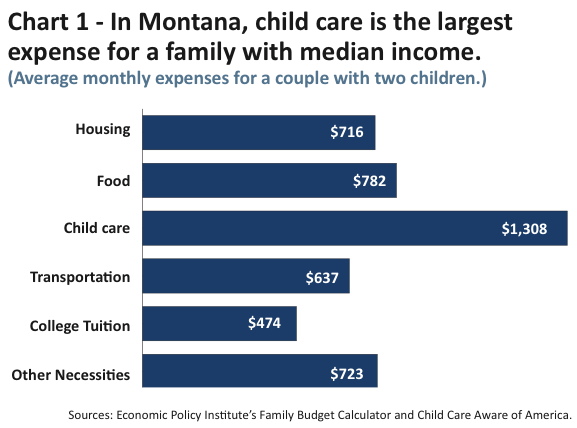 The U.S. Department of Health and Human Services (HHS) considers child care affordable if it consumes less than 10 percent of a family’s income.[4] However, even middle-class families spend above this affordability threshold on child care each month. For a two-parent family with median earnings ($74,340), the average cost of full-time care for two children is over $1,300 a month, 21 percent of their total income.[5],[6] In Montana, monthly child care costs exceed housing and college tuition expenses [Chart 1].[7]
Covering child care costs is a particular challenge for low-income families, especially those headed by single parents. In Montana, one in five families with children under the age of five live in poverty ($20,160 for a family of three). [8],[9] Poverty rates dramatically increase for households headed by a single-mother. One in two families with children under five and headed by a single-mother live in poverty.[10]
The U.S. Department of Health and Human Services (HHS) considers child care affordable if it consumes less than 10 percent of a family’s income.[4] However, even middle-class families spend above this affordability threshold on child care each month. For a two-parent family with median earnings ($74,340), the average cost of full-time care for two children is over $1,300 a month, 21 percent of their total income.[5],[6] In Montana, monthly child care costs exceed housing and college tuition expenses [Chart 1].[7]
Covering child care costs is a particular challenge for low-income families, especially those headed by single parents. In Montana, one in five families with children under the age of five live in poverty ($20,160 for a family of three). [8],[9] Poverty rates dramatically increase for households headed by a single-mother. One in two families with children under five and headed by a single-mother live in poverty.[10]
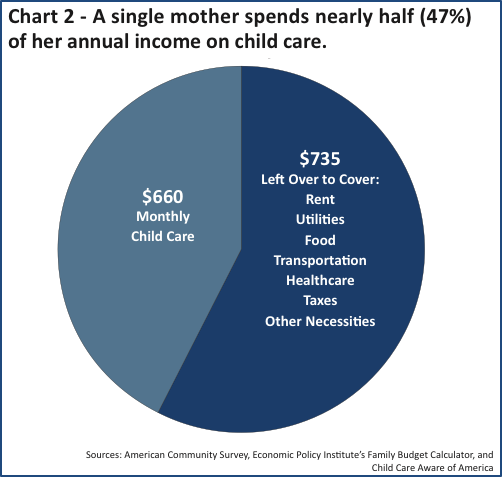 The steep cost of child care, combined with a low state median income, ranks Montana the 12th least affordable state for child care for families with a four-year-old.[11] For a single-mother working full-time and earning minimum wage, the cost to place her four-year old in full-time care takes up almost half – 47 percent – of her entire income [Chart 2].[12] This mom would need to contribute all of her earnings from January to June to pay for child care alone, directing limited resources away from other necessities like rent, food, health care, and transportation. This type of tough decision-making is also a problem for slightly higher earning families who do not qualify for assistance and must chose between paying a significant portion of their income to child care, placing their children in cheaper, lower-quality care, or leaving the workforce to care for their children.
For families with infants, child care is even more expensive. Child care providers who care for infants need more staff and additional training and licensing, which increases costs.[13] In 2014, the average annual cost of full-time infant care in Montana was over $9,000.[14] By HHS’s affordability metric, only 28 percent of families in Montana can afford infant care.[15]
The steep cost of child care, combined with a low state median income, ranks Montana the 12th least affordable state for child care for families with a four-year-old.[11] For a single-mother working full-time and earning minimum wage, the cost to place her four-year old in full-time care takes up almost half – 47 percent – of her entire income [Chart 2].[12] This mom would need to contribute all of her earnings from January to June to pay for child care alone, directing limited resources away from other necessities like rent, food, health care, and transportation. This type of tough decision-making is also a problem for slightly higher earning families who do not qualify for assistance and must chose between paying a significant portion of their income to child care, placing their children in cheaper, lower-quality care, or leaving the workforce to care for their children.
For families with infants, child care is even more expensive. Child care providers who care for infants need more staff and additional training and licensing, which increases costs.[13] In 2014, the average annual cost of full-time infant care in Montana was over $9,000.[14] By HHS’s affordability metric, only 28 percent of families in Montana can afford infant care.[15]
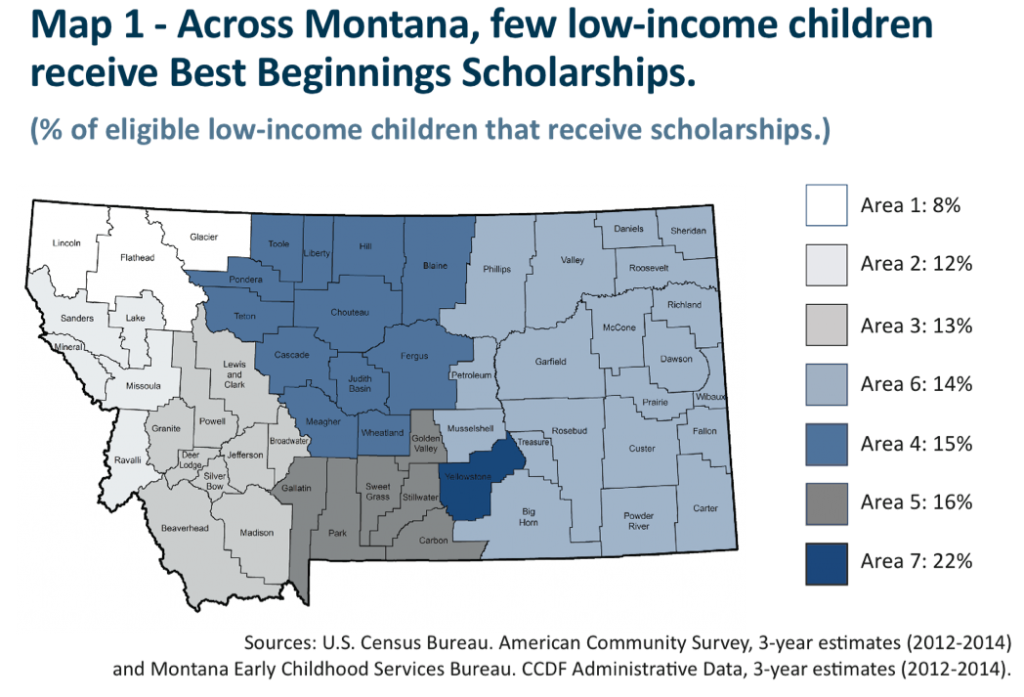
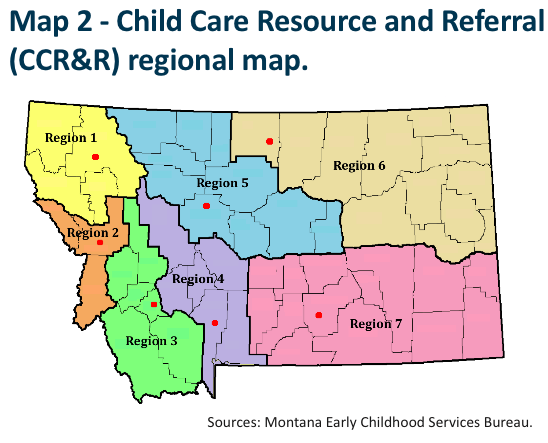 In Montana, seven centralized Child Care Resource and Referall (CCR&R) offices are located in seven regions of the state [Map 2].[25] Staff in CCR&R offices offer referral services to families looking for child care in their area and determine eligibility for Best Beginnings Scholarships. While the census areas in our analysis do not perfectly align with the seven CCR&R regions, our analysis gives a sense of Best Beginnings coverage across the regions.
Additionally, analysis by the Center for Law and Social Policy found that the Best Beginnings Scholarship program underserves children, despite their race or ethnicity [Chart 3]. The analysis, which examined participation in Best Beginnings between 2010 and 2014, found that on average, 4,000 white children received scholarships each month during each of the five years, but only 19 percent of the total population of white and eligible low-income children received assistance. Among American Indian children, 660 received scholarships each month during the five-year period, but this enrollment comprised only 13 percent of the total eligible population of American Indian children in Montana. This statistic does not include children participating in tribal child care assistance programs. Further, the gap between children in need and children receiving scholarships was even greater among Hispanic and Latino children. Only 10 percent of eligible Hispanic and Latino children received scholarships over this five-year period.[26]
In Montana, seven centralized Child Care Resource and Referall (CCR&R) offices are located in seven regions of the state [Map 2].[25] Staff in CCR&R offices offer referral services to families looking for child care in their area and determine eligibility for Best Beginnings Scholarships. While the census areas in our analysis do not perfectly align with the seven CCR&R regions, our analysis gives a sense of Best Beginnings coverage across the regions.
Additionally, analysis by the Center for Law and Social Policy found that the Best Beginnings Scholarship program underserves children, despite their race or ethnicity [Chart 3]. The analysis, which examined participation in Best Beginnings between 2010 and 2014, found that on average, 4,000 white children received scholarships each month during each of the five years, but only 19 percent of the total population of white and eligible low-income children received assistance. Among American Indian children, 660 received scholarships each month during the five-year period, but this enrollment comprised only 13 percent of the total eligible population of American Indian children in Montana. This statistic does not include children participating in tribal child care assistance programs. Further, the gap between children in need and children receiving scholarships was even greater among Hispanic and Latino children. Only 10 percent of eligible Hispanic and Latino children received scholarships over this five-year period.[26]
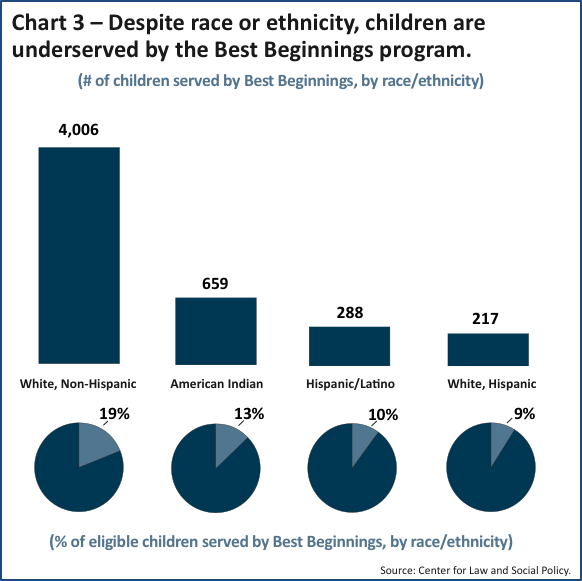
7,500 Montana families cannot afford child care on their own yet cannot qualify for assistance through Best Beginnings.Some families earn too much to qualify for Best Beginnings Scholarships, but too little to afford child care on their own. The Child Care Development Block Grant allows states to set a maximum income eligibility limit.[27] In 2014, states like Colorado, North Dakota, South Dakota, and Wyoming set their income eligibility rates between 180 percent and 300 percent FPL. Montana, however, sets its income eligibility limit at a level that disqualifies families for child care assistance, even if they have income that is too low to afford child care on their own. A family of three must earn less than $30,240 annually (150 percent FPL) to qualify for scholarships.[28] If a family’s earnings are slightly more than the state’s eligibility threshold, they are subject to pay the entire cost of care. Currently, about 7,500 Montana families are caught in this gap, earning too much to qualify for child care assistance, but still too little to afford child care on their own.[29] By increasing Montana’s eligibility threshold to the federally recommended level, an additional 30,000 children in Montana would become eligible for Best Beginnings Scholarships.[30] Application processes and eligibility requirements limit access. Families can apply for Best Beginnings Scholarships online or at CCR&R offices.[31] Unfortunately, many parents are denied eligibility, for reasons sometimes out of their control. In 2014, on average, almost half of the applications filed through CCR&R offices were denied.[32] While data on reasons for denial is unavailable, CCR&R and Early Childhood Services Bureau staff cite several reasons for denial. Activity Requirements for Best Beginnings Scholarships · Two-parent families must work at least 120 hours per month. · Single-parent families must work at least 60 hours per month. · Single-or two-parent families do not have to meet work requirements if all parents attend school or training full time. · Single-or two-parent families with one or more parents attending school or training part time must meet a work requirement that takes into account education or training. · Teen parents must attend high school or a high school equivalency program. First, parents applying for Best Beginnings Scholarships must submit paperwork from their employers that verify employment and work schedules. This is challenging, especially for low-wage workers whose employers may not cooperate. If an employer does not cooperate or submit paperwork within a 30-day window, parents are denied assistance through no fault of their own. Second, Montana is one of only 14 states that require parents to meet child support requirements to qualify for child care assistance.[33] In 2014, 87 percent of families receiving Best Beginnings Scholarships were headed by single parents and likely went through this process.[34] Single parents who do not receive regular child support must cooperate with the state’s Child Support Enforcement Division to provide proof of child support, either through court-ordered documents or court-approved parenting plans, or prove that the absent parent has relinquished their parental rights. Some parents, who are unable to pursue child support from non-custodial parents because “cooperation is likely to result in substantial danger” to the parent or child, may submit a “good cause” waiver for not meeting requirements.[35] Parents must still provide evidence for why they cannot claim child support.[36] However, this “good cause” exemption varies by family situation. Anecdotal evidence suggests many parents choose not to apply for scholarships as a result of difficulty in meeting child support requirements. It is clear that the overwhelming amount of paperwork and processes required to apply for scholarships are large barriers to applying. Additionally, parents may be ineligible for scholarships because they are unable to meet activity requirements. For example, a two-parent family is required to work at least 120 hours per month, about 15 hours per week per parent. In 2014, 70 percent of families receiving Best Beginnings Scholarships were working.[37] But not all working parents, especially single parents, can meet activity requirements. Many low-wage and seasonal workers have little control over their work schedules. When an employer cuts back on hours, it can cause parents to become ineligible for scholarships, again through no fault of their own. Montana’s Early Childhood Services Bureau (ECSB) has taken several steps to improve access to assistance for low-income families. Earlier this year, ECSB changed activity requirements so that parents who are full-time students no longer have to work full-time to qualify for scholarships. Further, the state has proposed implementing a graduated eligibility policy that would allow families to continue receiving scholarships for up to 6 months, even if their income increases up to 185 percent FPL.[38] Graduating eligibility would allow 160 families in Montana to continue receiving assistance while they build financial security.[39] Unfortunately, Montana does not allow parents searching for work to apply for scholarships. Currently, 13 states recognize “job search” as a qualifying activity for parents applying for assistance. In New Hampshire, for example, parents looking for work can apply for child care assistance and use receipt of compensation from unemployment insurance as proof of “job search” for a period of time.[40] Montana recently extended eligibility for Best Beginnings Scholarships for families that experience job loss, so that children can continue receiving care for 90 days while their parents search for work.[41] However, parents currently searching for work cannot apply for scholarships. Access to child care would support parents who need to prepare for and attend interviews and could increase their chances of securing work faster.
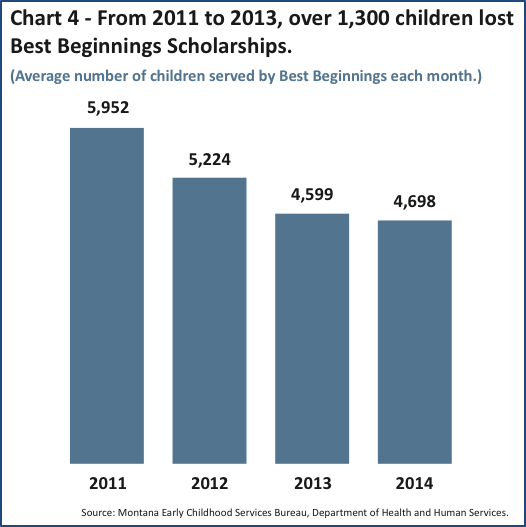 In 2015, Congress increased federal funding for CCDBG by $326 million to help states implement reauthorization requirements.[46] However, this increase accounts for less than one-third of the actual funding needed to cover costs associated with implementing reauthorization and managing caseloads. Between 2013 and 2014, 26 states increased their investment in child care assistance programs.[47] Montana should consider greater state investments to ensure that the Early Childhood Services Bureau can implement new CCDBG provisions without sacrificing families’ access to assistance.
Reduced funding hinders the state’s ability to reimburse child care providers. As funding for the Best Beginnings Scholarship program consistently declined from 2011 to 2014, over 1,300 Montana children lost their scholarships [Chart 4].[48] There are likely multiple reasons for this. As mentioned earlier, parents struggle to complete applications and submit employment verification, work schedules, and child support documents. But, with declining funds, Montana cannot reimburse child care providers at an adequate rate, which hurts providers and reduces options for low-income families.
While the Best Beginnings Scholarship program pays child care providers who serve some low-income families, parents must pay a portion of child care costs through monthly copayments. Copayments begin at $10 a month and increase based on family size and income.[49] In 2014, average monthly copays comprised about 4 percent of a family’s total income.[50] However, families may pay additional costs if child care providers are not adequately reimbursed.
Federal recommendations suggest that states reimburse child care providers at the 75th percentile of current provider market rates so that low-income families receiving assistance can afford 75 percent of the providers in their area.[51] In Montana, reimbursement rates vary by age groups, types of care, and region, but are often below the federally recommended level.[52] In 2014, for example, the average cost of full-time center care for a four-year old in Yellowstone County was $600 a month.[53] In this case, the 75th percentile of market rate was more than the average cost of care and the state should have reimbursed providers up to $600. Yet, the state only reimbursed providers $580 per month for each Best Beginnings family served [Chart 5].[54]
When providers face a gap between what they charge and what they are reimbursed, they can shift costs onto families to make up the difference, which for Best Beginnings families, may exceed their monthly copays. For example, if a child care center – known in this example as ABC Care - served three Best Beginnings families, they would be reimbursed $580 per month, per family, but lose over $700 per year because of low reimbursement rates.[55] In this scenario, ABC Care can shift costs onto families or choose not to serve Best Beginnings families at all. If ABC Care chooses to shift costs onto families, it could mean that a single mother who receives a scholarship and pays $70 a month in copays could pay an additional $20 a month to make up for the providers loss, the equivalent of a 30 percent increase in child care costs.[56] Alternatively, when low-income families stand to pay more than their copays, they may forgo assistance altogether and place children in unlicensed care, which can mean cheaper and lower quality care for children.
Some child care providers participate in Montana’s voluntary rating system, called Stars to Quality. Participating providers signal a higher quality of care to families and can receive tiered reimbursement rates between 5 to 20 percent above the state’s standard rates, depending on the STAR level they achieve.[57] For example, if ABC Care participated in STARS to Quality, they could have been reimbursed between $609 and $696 per month for each Best Beginnings family.[58] While the Stars to Quality program represents an important step in Montana’s investment in quality child care, providers participating in the program are still not guaranteed reimbursement at the federally recommended level.
Increasing state investment into Montana’s child care assistance program could help provide resources needed to reimburse child care providers at an adequate rate that enables them to maintain their small businesses and welcome low-income families. New investment could also encourage more providers to participate in Stars to Quality, increasing options for high quality care throughout Montana.
In 2015, Congress increased federal funding for CCDBG by $326 million to help states implement reauthorization requirements.[46] However, this increase accounts for less than one-third of the actual funding needed to cover costs associated with implementing reauthorization and managing caseloads. Between 2013 and 2014, 26 states increased their investment in child care assistance programs.[47] Montana should consider greater state investments to ensure that the Early Childhood Services Bureau can implement new CCDBG provisions without sacrificing families’ access to assistance.
Reduced funding hinders the state’s ability to reimburse child care providers. As funding for the Best Beginnings Scholarship program consistently declined from 2011 to 2014, over 1,300 Montana children lost their scholarships [Chart 4].[48] There are likely multiple reasons for this. As mentioned earlier, parents struggle to complete applications and submit employment verification, work schedules, and child support documents. But, with declining funds, Montana cannot reimburse child care providers at an adequate rate, which hurts providers and reduces options for low-income families.
While the Best Beginnings Scholarship program pays child care providers who serve some low-income families, parents must pay a portion of child care costs through monthly copayments. Copayments begin at $10 a month and increase based on family size and income.[49] In 2014, average monthly copays comprised about 4 percent of a family’s total income.[50] However, families may pay additional costs if child care providers are not adequately reimbursed.
Federal recommendations suggest that states reimburse child care providers at the 75th percentile of current provider market rates so that low-income families receiving assistance can afford 75 percent of the providers in their area.[51] In Montana, reimbursement rates vary by age groups, types of care, and region, but are often below the federally recommended level.[52] In 2014, for example, the average cost of full-time center care for a four-year old in Yellowstone County was $600 a month.[53] In this case, the 75th percentile of market rate was more than the average cost of care and the state should have reimbursed providers up to $600. Yet, the state only reimbursed providers $580 per month for each Best Beginnings family served [Chart 5].[54]
When providers face a gap between what they charge and what they are reimbursed, they can shift costs onto families to make up the difference, which for Best Beginnings families, may exceed their monthly copays. For example, if a child care center – known in this example as ABC Care - served three Best Beginnings families, they would be reimbursed $580 per month, per family, but lose over $700 per year because of low reimbursement rates.[55] In this scenario, ABC Care can shift costs onto families or choose not to serve Best Beginnings families at all. If ABC Care chooses to shift costs onto families, it could mean that a single mother who receives a scholarship and pays $70 a month in copays could pay an additional $20 a month to make up for the providers loss, the equivalent of a 30 percent increase in child care costs.[56] Alternatively, when low-income families stand to pay more than their copays, they may forgo assistance altogether and place children in unlicensed care, which can mean cheaper and lower quality care for children.
Some child care providers participate in Montana’s voluntary rating system, called Stars to Quality. Participating providers signal a higher quality of care to families and can receive tiered reimbursement rates between 5 to 20 percent above the state’s standard rates, depending on the STAR level they achieve.[57] For example, if ABC Care participated in STARS to Quality, they could have been reimbursed between $609 and $696 per month for each Best Beginnings family.[58] While the Stars to Quality program represents an important step in Montana’s investment in quality child care, providers participating in the program are still not guaranteed reimbursement at the federally recommended level.
Increasing state investment into Montana’s child care assistance program could help provide resources needed to reimburse child care providers at an adequate rate that enables them to maintain their small businesses and welcome low-income families. New investment could also encourage more providers to participate in Stars to Quality, increasing options for high quality care throughout Montana.
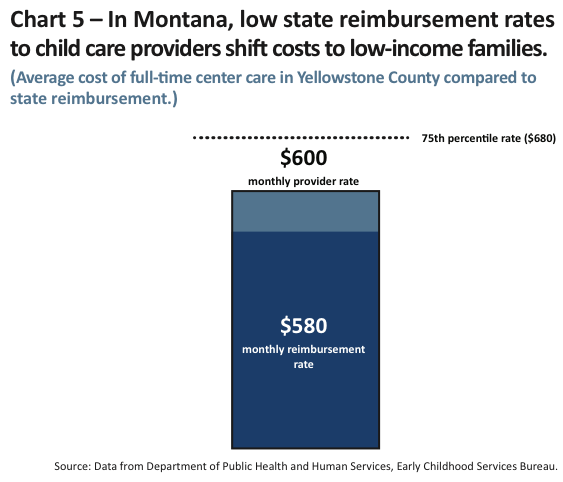

MBPC is a nonprofit organization focused on providing credible and timely research and analysis on budget, tax, and economic issues that impact low- and moderate-income Montana families.